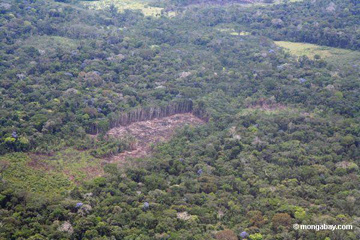Large-scale Amazon deforestation or drying would have dire global consequences
Large-scale Amazon deforestation or drying would have dire global consequences
Jeremy Hance, mongabay.com
February 21, 2008
A new study shows that large-scale degradation of the Amazon, either through drying or continued deforestation, would have global consequence, including worsening climate change, causing regional vegetation shifts, and increasing dust in the atmosphere.
Deforestation of the Amazon began in the 1960s when small farmers used slash and burn techniques to establish lands for crops. According to the study, by 2001, 13 percent of the Amazon was gone, a total of 800,000 square kilometers (nearly 500,000 square miles). Incorporating current development plans, it is estimated that by 2050, a total of 47 percent of the forest will be lost. The Amazon is often referred to as the earth’s lungs due to its atmospheric role and the amount of oxygen it produces — therefore it is not surprising that Dr. Richard Betts, of the Met Office Hadley Center, states that “loss of forest cover in Amazonia — would exert significant further influences on the local and global climate.”
According to the study’s analysis of possible vegetation dieback in this century, such dieback would cause local drying to rise by 26 percent — 30 percent in Western Amazonia. A loss of vegetation — or a change in the area of forest to non-forest — means “that the climate of the Amazon region would be further dried,” Dr. Betts explains, “as a result of a reduction in the recycling of rainfall by evaporation from the forest.”

|
Such a reduction in the Amazon forest would cause a large rise in global CO2 concentrations. In the study it was found that Amazon degradation would raise global temperatures by approximately 0.3 degrees Celsius. In this context, where the study assumed a total global temperature rise of 4.0 degrees Celsius, the Amazon’s forest loss alone accounted for 8 percent of future global warming. Such warming would certainly lead to a drier Amazon as well, thus contributing to a cycle where drying of the Amazon produces higher global temperatures and higher temperatures cause more drying.
Dr. Betts notes a final concern involving a drier and/or deforested Amazon: “Forest loss in the context of a drying climate could also lead to the Amazon region becoming a significant source of dust in the atmosphere.” In one scenario, dust yields from a dry Amazon produced more dust in the atmosphere than the Sahara desert by 2100. Wind would carry the dust all over the tropical Pacific and the north and south Atlantic.
Increased dust levels are significant because they can affect sea surface temperatures. Other research has shown than high sea surface temperatures — especially in the Tropical North Atlantic — are linked to drought in the Amazon. As such, dust from a deforested and degraded Amazon could further boost the devastating cycle of drying and warming in the region.
When one speaks of ‘saving the Amazon’ they often think of its monumental biodiversity: scientists believe that 1/3rd of the world’s species live in the Amazon basin. But what is becoming increasingly apparent is the Amazon’s critical role in the world’s natural systems. It is apparent from this study that dieback of the Amazon, whether due to man or increased drying, will cause widespread and complex changes to systems in every part of the world. Such a loss would both drive climate change and be worsened by climate change. There is more reason than ever to conserve the world’s largest forest.
“The climatic benefits of protecting the forest therefore extend beyond simply reducing carbon emissions,” Dr. Betts says, “it would preserve a whole range of ecosystem services.”
Richard Betts, Michael Sanderson and Stephanie Woodward (2008). Effects of large-scale Amazon forest degradation on climate and air quality through fluxes of carbon dioxide, water, energy, mineral dust and isoprene. Phil. Trans. R. Soc. B doi:10.1098/rstb.2007.0027.







